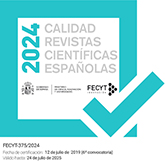Typological variation in the phonetic realization of lexical and phrasal stress: Southern British English vs. Tunisian Arabic
DOI:
https://doi.org/10.3989/loquens.2016.034Keywords:
Stress, Accent, Acoustic Correlates, Arabic, EnglishAbstract
Results of phonetic experiments on the acoustic correlates of lexical stress (word-level prominence) and phrasal stress (phrase-level prominence = accent) as two separate concepts in two typologically different languages, Southern British English (SBE) and Tunisian Arabic (TA), are reported in this study. Because of the confusion in the literature between the terms stress and accent, their acoustic correlates were muddled, too. To avoid this confusion, the data in this study are elicited using an experimental paradigm which allows careful investigation of the correlates of each concept independently. The duration, spectral balance, and vowel quality cues are measured. Results show cross-linguistic similarities and differences between the two languages. Unlike most world languages, duration in TA is not a correlate of stress. It is rather a correlate of accent. In the absence of focus on the target words in TA, the only phonetic characteristics of lexical stress that come in the foreground are spectral balance and F1 lowering. However, when the word is focused, Tunisian speakers rely mainly on duration and spectral balance to signal accent. SBE signals stress through three acoustic correlates which are duration, spectral balance, and vowel quality. More similarity is found for accent detection between speakers of the two languages.
Downloads
References
Baart, J. L.G. (1987). Focus, syntax, and accent placement: towards a rule system for the derivation of pitch accent patterns in Dutch. PhD Dissertation , Leiden University.
Beckman, M. (1986). Stress and non-stress accent. Dordrecht: Foris. https://doi.org/10.1515/9783110874020
Beckman, M., Edwards, J.R., & Fletcher, J. (1992). Prosodic structure and tempo in a sonority model of articulatory dynamics. In G. Docherty and D.R. Ladd (Eds.), Papers in Laboratory Phonology, 2. Cambridge University Press: Cambridge, 68-86. https://doi.org/10.1017/cbo9780511519918.004
Ben Slama, N. (2002). The factors influencing syllable structure in Standard Arabic. Unpublished MA Thesis, University of Carthage, Tunisia.
Berinstein, A. (1979). A cross- linguistic study on the perception and production of stress. Working Papers in Phonetics, 47. University of California, Los Ángeles.
Braham, AF. (1997).The temporal organization of speech in Arabic (a perceptual study). PhD Dissertation. Faculty of Letters, La Manouba, University of Tunis I.
Bond, D. (1991). Vowel and word duration in Latvian. Journal of Baltic Studies, 22, 133-144.
Crosswhite, K (2003). Spectral tilt as a cue to word stress in Polish, Macedonian and Bulgarian. Proceedings of the 15th International Congress of Phonetic Science, Barcelona.
De Jong, K, & Zawaydeh, B. (1999). Focus, phonological focus, quantity, and voicing effects on vowel duration in Ammani Arabic. Proceedings of the 14th International Congress of Phonetic Sciences, San Francisco.
Fry, D.B (1958). Experiments in the perception of stress. Language and Speech, 1, 126-152.
Gordieva, O., Mennen, I., & Scobbie, J. (2003). Vowel duration and spectral balance in Scottish English and Russian. Proceedings of the 15th International Conference of Phonetic Sciences, Barcelona.
Harris, J (2004). Vowel reduction as an information loss. In P. Carr, J. Durand, & C.J. Ewen (Eds.), Headhood, elements, specification, and contrastivity (pp. 121-132). Amsterdam: John Benjamins.
Ladd, R.D. (1980). The structure of intonational meaning: Evidence from English. Bloomington: Indiana University Press. PMCid:PMC2044183
Lehiste, I. (1970). Suprasegmentals. Cambridge, M.A: MIT Press.
Levi, S.V. (2005). Acoustic correlates of lexical accent in Turkish. Journal of the International Phonetic Association, 35(1), 73-97. https://doi.org/10.1017/S0025100305001921
Lieberman, P. (1960). Some acoustic correlates of word stress in American English. Journal of the Acoustical Society of America, 32, 451-454. https://doi.org/10.1121/1.1908095
Mc Clean, M.D., & Tiffany, W.R. (1973). The acoustic parameters of stress in relation to the syllable position, speech loudness, and rate. Language and Speech, 16, 283-290.
Rajouani, A., Najim, A., Chiadmi, D., & Zyoute, M. (1987). Synthesis- by-rule of Arabic language. European Conference on Speech Technology. Edinburgh, Scotland.
Remijsen, B. (2001). Word-prosodic systems of Raja Ampat languages. Leiden: LOT Utrecht publishers. PMid:12162695
Sluijter, A.M. (1995). Phonetic correlates of stress and accent. PhD Dissertation. University of Leiden.
Sluijter, A.M.C. & Van Heuven, V. (1996). Spectral balance as an acoustic correlate of linguistic stress. Journal of the Acoustic Society of America, 100(4), 2471-2485. https://doi.org/10.1121/1.417955
Sluijter, A. M., Shattuck-Hufnagel, K. N., Stevens, V.J., & Van Heuven, V. (1995). Supra-laryngeal resonance and glottal pulse shape as correlates of prosodic stress and accent in American English. Proceedings of the 13th Congress of Phonetic Sciences, Stockholm, 630-633.
Turk, A. & Sawusch, J. R. (1997). The domain of accentual lengthening in American English. Journal of Phonetics, 25, 25-41. https://doi.org/10.1006/jpho.1996.0032
Turk A. & White, L. (1999). Structural influences on accentual lengthening in English. Journal of Phonetics, 27, 171-206. https://doi.org/10.1006/jpho.1999.0093
Turk, A., Nakai, S. & Sugahara, M. (2006). Acoustic segment durations in prosodic research: A practical guide. In Sudhoff, S., D. Lenertová, R. Meyer, S. Pappert, P. Augurzky, I. Mleinek, N. Richter & J. Schließer (Eds.) Methods in Empirical Prosody Research. Berlin, New York: De Gruyter, 1-28. https://doi.org/10.1515/9783110914641.1
Williams, B. (1985). Pitch and duration in Welsh stress perception: the implications for intonation. Journal of Phonetics, 13, 381-401
Published
How to Cite
Issue
Section
License
Copyright (c) 2016 Consejo Superior de Investigaciones Científicas (CSIC)

This work is licensed under a Creative Commons Attribution 4.0 International License.
© CSIC. Manuscripts published in both the print and online versions of this journal are the property of the Consejo Superior de Investigaciones Científicas, and quoting this source is a requirement for any partial or full reproduction.
All contents of this electronic edition, except where otherwise noted, are distributed under a Creative Commons Attribution 4.0 International (CC BY 4.0) licence. You may read the basic information and the legal text of the licence. The indication of the CC BY 4.0 licence must be expressly stated in this way when necessary.
Self-archiving in repositories, personal webpages or similar, of any version other than the final version of the work produced by the publisher, is not allowed.














